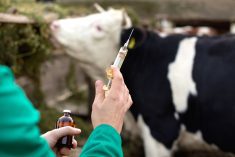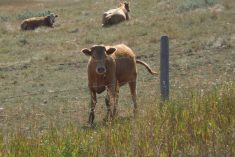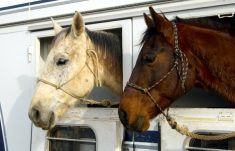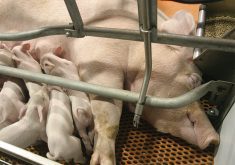Alberta hog producers are no closer to answers about how a devastating virus found its way into the province after a third case of porcine epidemic diarrhea virus (PEDv) was confirmed at the start of March.
“There are several possibilities about how it’s spreading that involve transportation, and we’re still looking into that at this time,” said Dr. Julia Keenliside, veterinary epidemiologist with Alberta Agriculture and Forestry.
“But there’s definitely a risk to the Alberta pork industry that the virus will continue to spread.”
Read Also

Farming Smarter receives financial boost from Alberta government for potato research
Farming Smarter near Lethbridge got a boost to its research equipment, thanks to the Alberta government’s increase in funding for research associations.
After a 400-sow central Alberta farm first discovered the virus on Jan. 7, a second case was reported on Feb. 21 at a 600-sow farrow-to-finish operation in southern Alberta. The exact location of the second farm hasn’t been released, but officials said it is not close to the first farm.
Then, on March 1, a third and fourth case of PEDv were reported within two hours of each other. One of those cases has since been deemed a false positive, but the virus has been confirmed at the other, a 300-sow farrow-to-finish operation in southern Alberta.
And while there appear to be no connections between the first two cases, officials are exploring possible links between the second and third farms based on their proximity.
“We’ve been doing an intensive investigation into all possible connections between the second and the third case because they’re both in southern Alberta,” Keenliside said March 5.
“We have not come up with any obvious means of it moving between the two farms at this stage, but there have been enough places in the biosecurity practices in both farms that it’s possible it could have been transmitted.”
Contaminated trailers are the likeliest culprit, she added.
“The No. 1 way it moves when it enters a region is on contaminated hog trailers,” she said.
“We know that the PED virus can be very sneaky. It exploits even the smallest hole in biosecurity.
“But you can go a long way by plugging up the obvious holes in biosecurity.”
The risk is going up
That will become increasingly important as the snow melts and conditions turn mucky.
“We’re heading into mud and slush season, and we know that mud and slush can carry it from one facility to another,” said Keenliside.
“If there’s any virus that’s been tracked around outside of a barn, it’s going to be easier to transmit it on boots and vehicles.
But PEDv can spread no matter how good the biosecurity is, she added.
“We’ve learned that from Manitoba, where’s some of the most biosecure, well-run operations have PED,” said Keenliside.
That appears to be the case for the second confirmed infection in Alberta. In that operation, the virus was found in an isolated room of grower pigs that were not slaughter weight.
“The internal biosecurity of this farm is very good,” said Dr. Frank Marshall, swine veterinarian with Marshall Health Services.
“They have a good handle on not moving things between rooms or having staff go in and out of rooms. It did not spread out of that room.
“Trying to wrap your head around that is a tough one. These pigs are in the middle of production. It did not hit the babies or the sows. It’s localized in one grower room. It’s really disconcerting.”
The infected animals had diarrhea but it presented as a regular version. Nevertheless, the producer asked a veterinarian to check on it.
“The veterinarian wasn’t thinking this was, in any shape or form, PEDv,” said Marshall.
While suckling pigs will die from PED, adult pigs typically recover from the diarrhea and vomiting caused by the virus.
Because the virus is in feces, it is easily spread, but the initial indications are that did not happen at the second operation.
The financial hit
And if it does continue to spread, the impact on Alberta’s pork industry could be devastating, he added.
“When this thing hit North America, between the U.S. and Canada, we lost 10 million pigs that never made it to market that year,” said Marshall. “It was a big hit to the industry.”
Each of the three infected farms will lose roughly one month of production as a result of PEDv. And it’s a hit the industry can’t afford to take. Last year, the cost of production for a pig was between $1.60 to $1.65 per kilogram, while the average price was closer to $1.50 per kilogram. But now, that loss has risen to around 30 cents per kilogram, or $30 a head for an average 100-kilogram hog.
For a 500-sow farm, which will lose about 1,000 pigs right off the bat, that’s at least $30,000 in lost revenue for the month, but there will also be lost pregnancies and productivity as sick pigs recover from the virus.
“That’s a fair hole in production,” said Marshall.
Meanwhile, while the virus is running its course at the infected farms, the search for its origin is still continuing.
“All of the leads have basically come up empty handed,” he said. “The sense is there are no connections between these cases. There are more questions than answers for the whole industry.”
Feed ingredients are being tested, “but this testing is incomplete and inconclusive at this time,” Alberta Pork said in a release.
The first operation will be able to completely clean everything out and have virus-free pigs, said Keenliside.
The pigs will be moved to a slaughter facility, likely in the U.S., since all Canadian plants are PEDv negative. That can’t occur until it’s confirmed that none are shedding the virus, and then the animals will be moved under strict biosecurity protocols.
Officials are also continuing with enhanced surveillance. High-traffic sites in Alberta such as assembly yards, abattoirs, and trucks are being sampled for the virus — in some cases, sites are being sampled every day, said Keenliside.
“We’ve added some sites and we have not found any positives so far,” she said. “But it doesn’t mean that the virus is not at any of those sites, it just means we didn’t find it.
“It’s not likely that it’s there but it could be.”
Strict biosecurity
So producers should treat all high-traffic sites, especially assembly yards and abattoirs, as if the virus might be there, she said. That’s doubly true for transport trucks.
“Trucks and trailers absolutely have to be washed, dried, and disinfected before going back to the farm,” she said. “Boots and coveralls need to be changed before you go into your barn and before you leave the barn. Keep your barn boots and your barn clothes in the barn.”
Keenliside also urged producers to be really aware of their own biosecurity, especially with hog transport, but also in terms of things such as feed, feed ingredients, and equipment and people coming onto the farm.
“Many farms have visitor logs so they can keep track of everyone who has been there,” she said. “We go back and we look at everybody who has been on the farm two weeks before to see if there are any connections or links.”
As well, any cases of diarrhea or vomiting in adult pigs should be checked by a veterinarian as early detection is critical.
“We’re really lucky because in both of these (first two) cases, we have producers who were very quick to contact their vets and say, ‘I think there’s something wrong here,’” said Keenliside. “And their vets acted quickly and got it tested.
“Because the producer and their vet moved quite quickly, we were able to contain it quite fast. Early detection and rapid response are really key in preventing the spread.”
PEDv is a provincially reportable disease, and officials with Alberta Agriculture, the Office of the Provincial Veterinarian, and Alberta Pork are working closely together in “joint command system” to help manage the virus.
“PEDv is a collaborative disease — you have to collaborate to prevent it,” said Keenliside. “The whole chain has to work together — truckers, abattoir workers, producers, and veterinarians — to contain it and prevent it from spreading further.
“Just because there’s PED in Alberta doesn’t mean it has to make it into your barn.”
Marshall agrees.
“It’s scaring the heck out of the industry,” he said. “We really need to have everybody buckle down and keep on being diligent about this.”
















